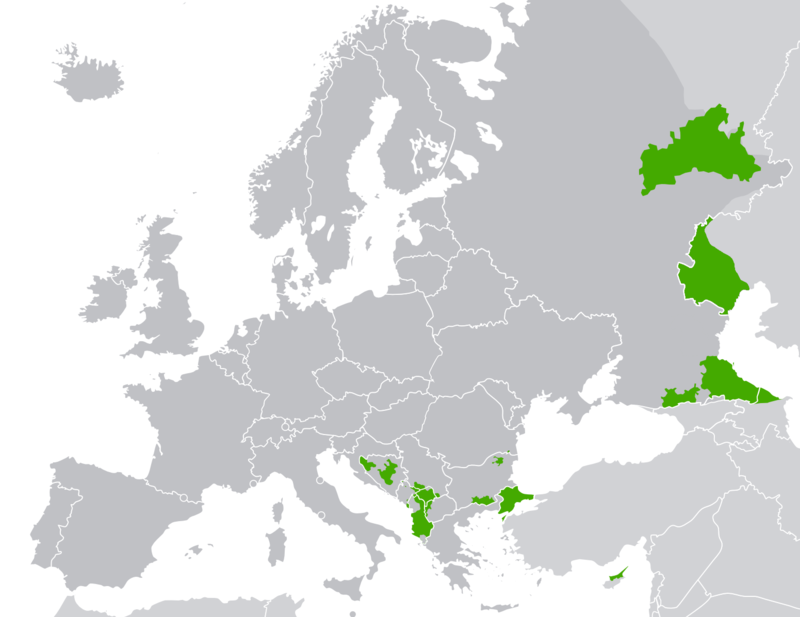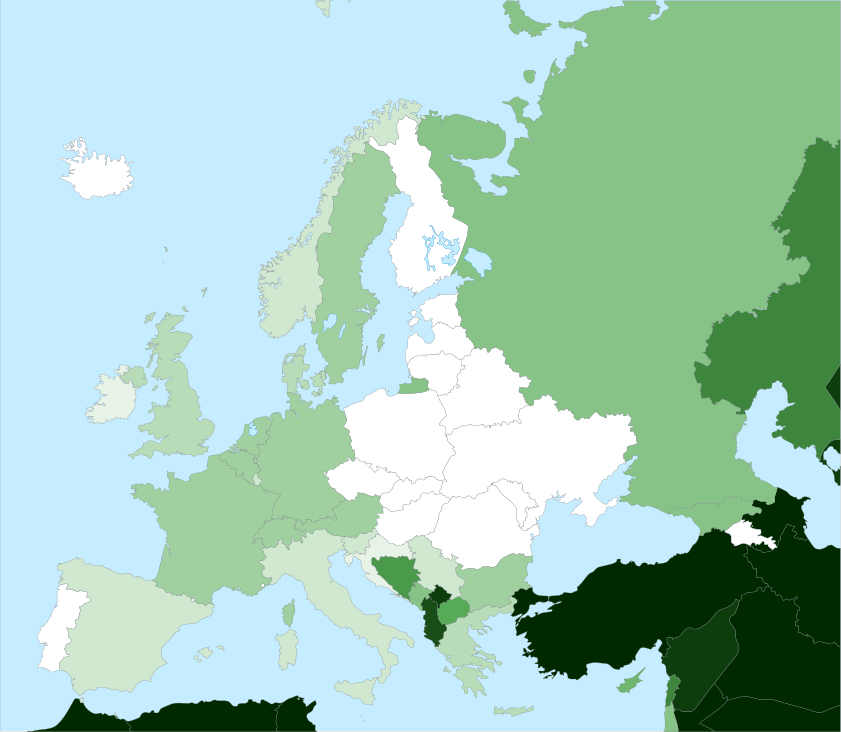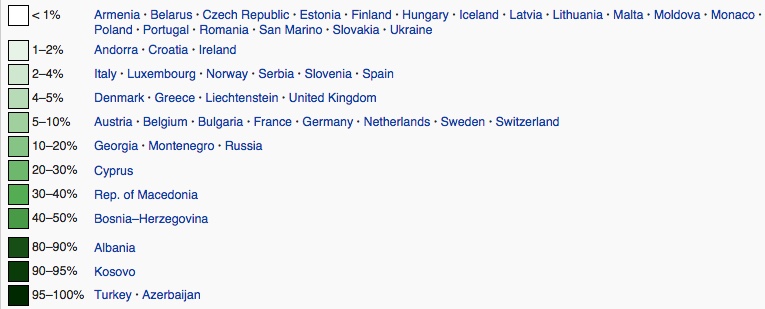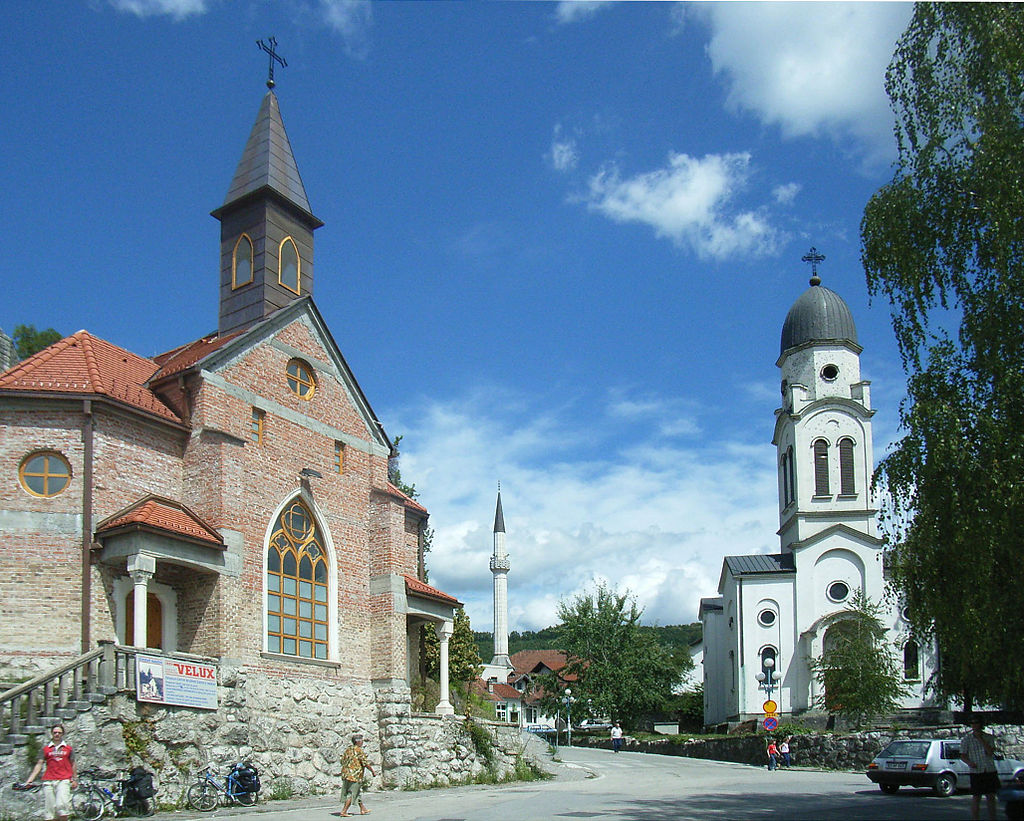1. Introduction about contemporary religious pluralism
Religious affiliations in Europe according to the 2008 EVS Survey
Do you belong to a religious denomination?
| (% of valid answers) | |
| Yes | 76. 4 |
| No | 23.6 |
| Total | 100.0 |
Led in 2008 in 47 countries*, the survey on European values reveals that more than 3/4 of them still identify in a religion, even though this may represent very different commitments and practices in each country
Which religious denomination do you belong to?
| (% of valid answers) | |
| roman catholic | 36.7 |
| protestant | 14.5 |
| free church/non-conformist/evangelical | 0.6 |
| jew | 0.2 |
| muslim | 15.0 |
| hindu | 0.1 |
| buddhist | 0.1 |
| orthodox | 30.6 |
| other | 2.3 |
| Total | 100.0 |
*The 2008 European Values Study (EVS) was conducted in 47 European countries: Albania, Armenia, Austria, Azerbaijan, Belgium, Bosnia and Herzegovina, Belarus, Bulgaria, Croatia, Czech Republic, Cyprus, Denmark, Estonia, Finland, France, Germany, Georgia, Great Britain, Greece, Hungary, Iceland, Ireland, Italy, Kosovo, Latvia, Lithuania, Luxembourg, Macedonia, Malta, Republic of Moldova, Republic of Montenegro, Netherlands, Northern Cyprus, Northern Ireland, Norway, Poland, Portugal, Romania, Russian Federation, Republic of Serbia, Slovak Republic, Slovenia, Spain, Sweden, Switzerland , Turkey, Ukraine.
by EUREL. Sociological and legal data on religions in Europe
Created: February 2014
http://www.eurel.info/spip.php?rubrique574&lang=en
This table, these two maps and the picture give a view of the religious and denominational (i.e. internal to one specific religion) diversity in Greater Europe (the 47 countries members of the Council of Europe).
The table shows that 3/4 of European people declare they have a religious affiliation (a lesser proportion would be given if the figures concern the countries members of the UE only). Another statistical sources show that the highest level of affiliation are in Poland, Turkey, Romania while the lowest are in Sweden, the Czech Republic and the Netherlands. Note that to declare an affiliation to a religion is not the same as to have religious beliefs and religious practices. Affiliation figures are a picture of religious identities, frequently bound to (and influenced by) national or ethno-national identities.
Moreover, the table shows that the two main denominations are Catholicism (mostly present in Western and Southern Europe) and Christian Orthodoxy (present in Russia and South-Eastern Europe). Islam and Protestantism come then almost at the same level (Islam is present in Turkey and some Balkan States while Protestantism is principally present in Northern and Central Europe).
Note that a map with UE members only would have given a very different result with Catholicism and Protestantism as the two main religious groups
Comparison between sources 2a and 2b allows us to understand the evolution of the Muslim presence in Europe. Map 2a displays the traditional presence of Muslims in the European continent with the areas where they have a majority, while map 2b displays the countries which now have most of Muslim people (or most exactly speaking, people who share a Muslim cultural heritage but who are not necessarily Muslim believers). The difference is striking concerning, on one hand, countries like France, Germany, Sweden – and to a lesser extent Great Britain, Italy and Spain – where Muslim population is mostly the product of recent migrations (rather during the 60s in Central Europe and rather during the 80s or 90s in Southern Europe), and, on the second hand, parts of Eastern Europe (Russia and the Balkans) where it is the result of long-term history. As for Asian religions (mostly Hinduism and Buddhism in its different denominations), most of people of Muslim heritage (in Western Europe, but not in Eastern Europe) are migrants or from recent migrant ancestry.
Map of Muslim majority areas in Europe

This table, these two maps and the picture give a view of the religious and denominational (i.e. internal to one specific religion) diversity in Greater Europe (the 47 countries members of the Council of Europe).
The table shows that 3/4 of European people declare they have a religious affiliation (a lesser proportion would be given if the figures concern the countries members of the UE only). Another statistical sources show that the highest level of affiliation are in Poland, Turkey, Romania while the lowest are in Sweden, the Czech Republic and the Netherlands. Note that to declare an affiliation to a religion is not the same as to have religious beliefs and religious practices. Affiliation figures are a picture of religious identities, frequently bound to (and influenced by) national or ethno-national identities.
Moreover, the table shows that the two main denominations are Catholicism (mostly present in Western and Southern Europe) and Christian Orthodoxy (present in Russia and South-Eastern Europe). Islam and Protestantism come then almost at the same level (Islam is present in Turkey and some Balkan States while Protestantism is principally present in Northern and Central Europe).
Note that a map with UE members only would have given a very different result with Catholicism and Protestantism as the two main religious groups
Comparison between sources 2a and 2b allows us to understand the evolution of the Muslim presence in Europe. Map 2a displays the traditional presence of Muslims in the European continent with the areas where they have a majority, while map 2b displays the countries which now have most of Muslim people (or most exactly speaking, people who share a Muslim cultural heritage but who are not necessarily Muslim believers). The difference is striking concerning, on one hand, countries like France, Germany, Sweden – and to a lesser extent Great Britain, Italy and Spain – where Muslim population is mostly the product of recent migrations (rather during the 60s in Central Europe and rather during the 80s or 90s in Southern Europe), and, on the second hand, parts of Eastern Europe (Russia and the Balkans) where it is the result of long-term history. As for Asian religions (mostly Hinduism and Buddhism in its different denominations), most of people of Muslim heritage are migrants or from recent migrant ancestry.
CC BY-SA 3.0
Image under URL:
http://en.wikipedia.org/wiki/Islam_in_Europe#/media/File:IslamInEurope.png
Islam in Europe by percentage of country population

Muslim Percentage in Europe in 2010

This table, these two maps and the picture give a view of the religious and denominational (i.e. internal to one specific religion) diversity in Greater Europe (the 47 countries members of the Council of Europe).
The table shows that 3/4 of European people declare they have a religious affiliation (a lesser proportion would be given if the figures concern the countries members of the UE only). Another statistical sources show that the highest level of affiliation are in Poland, Turkey, Romania while the lowest are in Sweden, the Czech Republic and the Netherlands. Note that to declare an affiliation to a religion is not the same as to have religious beliefs and religious practices. Affiliation figures are a picture of religious identities, frequently bound to (and influenced by) national or ethno-national identities.
Moreover, the table shows that the two main denominations are Catholicism (mostly present in Western and Southern Europe) and Christian Orthodoxy (present in Russia and South-Eastern Europe). Islam and Protestantism come then almost at the same level (Islam is present in Turkey and some Balkan States while Protestantism is principally present in Northern and Central Europe).
Note that a map with UE members only would have given a very different result with Catholicism and Protestantism as the two main religious groups
Comparison between sources 2a and 2b allows us to understand the evolution of the Muslim presence in Europe. Map 2a displays the traditional presence of Muslims in the European continent with the areas where they have a majority, while map 2b displays the countries which now have most of Muslim people (or most exactly speaking, people who share a Muslim cultural heritage but who are not necessarily Muslim believers). The difference is striking concerning, on one hand, countries like France, Germany, Sweden – and to a lesser extent Great Britain, Italy and Spain – where Muslim population is mostly the product of recent migrations (rather during the 60s in Central Europe and rather during the 80s or 90s in Southern Europe), and, on the second hand, parts of Eastern Europe (Russia and the Balkans) where it is the result of long-term history. As for Asian religions (mostly Hinduism and Buddhism in its different denominations), most of people of Muslim heritage are migrants or from recent migrant ancestry.
Image retrieved https://en.wikipedia.org/wiki/Islam_in_Europe#/media/File:Islam_in_Europe-2011.svg
(24/07/2015)
CC BY-SA 3.0
Table data retrieved in
http://www.pewforum.org/2011/01/27/table-muslim-population-by-country/
Juxtaposition of three religious buildings in the same town, Bosanska Krupa, a town of Bosnia

Bosanska Krupa is a small town in Bosnia and Herzegovina, a federal state born from the dissolution of Yugoslavia in the 1990s, which is characterized by the coexistence of three religious groups: Christian Catholic, Christian Orthodox and Muslim: for this reason, this town has a Catholic church, an Orthodox church and a mosque. Each denomination refers to a national-ethnic community: Croatian for Catholics, Serbian for Orthodox and Bosniak for Muslims (note that the term “Bosniak” refers to this sub-national identity whilst the term “Bosnian” refers to the citizenship of the Federal State of Bosnia and Herzegovina). This religious plurality is a legacy of history because the territory of present Bosnia was at the intersection between the Latin and the Greek parts of the Roman Empire. The presence of a Muslim community comes from conversion of Slav people to Islam during the Othman domination (15th to 19th centuries). During the Bosnian war (1992-1995), many religious buildings of a minority group were destroyed by the ethnical group dominant in a region (mosques in areas dominated by Serbs and vice versa) in a will of “ethnic purification” that led to many atrocities. This contemporary war has been reminiscent of religious wars that have torn the European continent in the past. Still today, peace between communities is fragile so much that the Organization for Security and Co-operation in Europe (OSCE) has appointed a “High Representative” in Bosnia who is empowered to cancel any law or decree that could threaten the balance between three “constituent peoples” of the country.
Photography by Mazbln - Own work.
Licensed under CC BY-SA 3.0 via Wikimedia Commons
http://commons.wikimedia.org/wiki/File:Bosanska_Krupa_Churches.JPG#/media/File:Bosanska_Krupa_Churches.JPG






